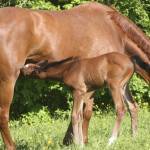Nutrition of Mares Influences Milk Characteristics and Development of Foals

The nutrition of the mare affects growth and development of the foal both in utero and via milk production. In foals, these effects carry over for a year or more.
In one study, 15 one-day-old foals fed milk replacer for seven weeks were compared with five foals that nursed their mares. During the first two weeks, replacer-fed foals did not gain weight as rapidly as mare-nursed foals. The resulting insulin-like growth factor 1 (IGF-1; a hormone that plays an important role in growth) values for replacer-fed foals were lower than values for mare-nursed foals. After the first two weeks, gains were similar between the two groups; however, serum IGF-1 concentrations of replacer-fed foals were only 36% and 60% of values obtained for mare-nursed foals at eight weeks and four and a half months of age, respectively.
The differences between mare-nursed and replacer-fed foals in serum IGF-1 concentrations persisted to one year of age, when the serum IGF-1 concentration of mare-nursed foals was 48% higher than that of replacer-fed foals.
Energy demands for lactation are among the highest for horses. Mares can produce 26 lb (11.8 kg) of milk per day or 2.3% of their body weight during the first 30 days of lactation. Researchers have determined milk yield in Quarter Horse mares for early lactation (2-29 days) and late lactation (60-120 days). Daily milk production was greater during early lactation compared to midlactation (12.1 vs. 10.8 kg, respectively) and tended to be greater during midlactation in multiparous mares (mares that gave birth to more than one foal) compared to primiparous mares (mares that gave birth to one foal) (11.7 vs. 10.4 kg, respectively) but was similar between groups in late lactation.
The extreme demands for glucose during early lactation may represent a time when feeds with higher glycemic responses would benefit the mare and foal. Foals can begin digesting grain within two weeks of birth. It is eight weeks before a functional hindgut contributes to the overall nutrition of the foal through forage-processing. Declines in milk production and nutrient concentrations after two months may represent a time when foals should be given supplemental feed.
The effects of dietary carbohydrates and fat on milk composition and fatty acid profile of mare’s milk were reported in another study. The sugar and starch diet (SS) was high in corn and molasses (62.4% NSC) while the fat and fiber diet (FF) was high in corn oil, beet pulp, soy hulls, and oat straw (26.5% NSC). The findings revealed a 4.2-fold increase in IgG (antibody molecule) concentration from the colostrum of mares fed the FF diet versus the mares fed the SS diet 6 to 12 hours post foaling.
The researchers suggested that the 4.2-fold increase in IgG in the colostrum collected 6 to 12 hours post foaling in the previous study was due to the vitamin E content of the corn oil (327 IU/kg). Corn oil is high in omega-6 fatty acids (linoleic acid). Thus, the researchers suggested that higher linoleic acid content of the milk would protect against gastric ulcers.
Would you like to know more? Read the entire article in Advances in Equine Nutrition IV.








